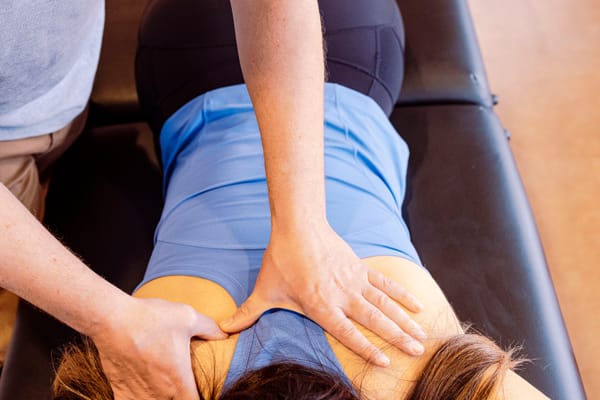
Relieve Muscle Spasms with Expert Sports Massage in Austin
These spasms often occur because the pathway is impeded, meaning the area doesn't get enough blood, oxygen, nutrients, or hormones.
Understanding Muscle Spasms: What You Need to Know
Muscle spasms, or cramps, are sudden, involuntary contractions of one or more muscles. Their discomfort and limited mobility can significantly impact daily activities and overall quality of life. These spasms often occur because the pathway is impeded, meaning the area doesn't get enough blood, oxygen, nutrients, or hormones. The spasm is a sign from your body to take action, indicating that the affected muscles are not receiving adequate support.
Muscle spasms can be viewed as the body's alarm system, signaling an imbalance or deficiency that needs addressing. When a muscle contracts involuntarily, it may be attempting to protect itself from further injury or damage due to the lack of essential resources. Iler Method Therapy helps by opening these pathways with trigger point therapy, ensuring the muscles receive the necessary blood flow and nutrients to function correctly. Our comprehensive clinical massage approach addresses the immediate symptoms and the underlying issues.
Using Trigger Point Therapy to Treat Muscle Spasms
Muscle spasms, or cramps, are a common issue that can significantly impact daily activities and overall quality of life. Understanding the causes, symptoms, and effective treatment methods is crucial for managing and alleviating this condition. The Iler Method Therapy offers a comprehensive approach to treating muscle spasms through trigger point therapy, addressing both the immediate symptoms and underlying causes of spasms.
The Iler Method incorporates trigger point therapy as a critical component of its broader clinical massage strategy. While trigger point therapy focuses on localized tight areas within muscles that can cause referred pain elsewhere, the Iler Method integrates this with a comprehensive evaluation of the body's muscular balance. This approach is especially beneficial for those experiencing chronic pain and looking to improve their athletic performance and injury prevention.
Our evaluation includes a thorough Discovery Session encompassing a formal intake from the client, a walking discovery to identify asymmetries and an on-table pain assessment. This detailed initial evaluation ensures the treatment addresses each client's unique needs and conditions, setting a solid foundation for effective therapy, particularly for muscle spasms. This personalized treatment plan is essential for targeting problem areas and enhancing recovery time.
We don't use oils, allowing clients to dress comfortably during their sessions and eliminating the need for a post-session shower. No oils facilitate the incorporation of treatments into busy schedules and contribute to a more straightforward and less intrusive therapeutic environment. By eliminating music, the setting encourages more open communication, allowing for better feedback between the client and therapist.
Additionally, this approach forgoes stretching and focuses on the muscle bellies rather than just the insertions, where the most significant tension relief and therapeutic work are often needed. This holistic and personalized strategy ensures that each session effectively targets individual health needs, making it an effective way to treat muscle spasms. Integrating various massage techniques, including sports massage therapy, helps address soft tissues, connective tissue, and muscle pain, promoting better sports performance and overall well-being.
The Iler Method's years of experience in medical massage and sports therapy have shown that a well-rounded approach to treatment not only alleviates pain but also enhances athletic performance and prevents future injuries. If you or someone you know is struggling with muscle spasms, consider exploring the Iler Method for a non-surgical, effective treatment option.
With its focus on comprehensive care and holistic healing, the Iler Method can help you return to your activities with reduced pain and increased comfort, ultimately leading to better muscle health and improved quality of life.
Identifying Symptoms of Muscle Spasms
- Sudden, Involuntary Contractions: The most immediate symptom of muscle spasms is sudden and involuntary contractions of a muscle or group of muscles, often affecting deeper layers of muscle.
- Sharp Pain: Muscle spasms often cause sharp, intense pain lasting from a few seconds to several minutes, impacting the nervous system and the affected muscle.
- Tightness in the Muscle: A spasm can make the affected muscle feel tight or knotted, often noticeable upon touch. This tightness can extend to tense muscles throughout the body.
- Muscle Twitching: Visible muscle twitching or jerking can occur repeatedly and rhythmically, indicating underlying issues with blood circulation and the nervous system.
- Difficulty Moving: Muscle spasms can limit the range of motion and make it difficult to move the affected limb or body part, potentially leading to joint pain and reduced mobility.
- Hard Lumps Under the Skin: The formation of hard, knot-like lumps under the skin is a trigger point or area of intense muscle tension, often found in tight muscles.
- Persistent Ache: A persistent ache or soreness in the muscle can remain after the initial spasm subsides, causing continuous discomfort and affecting stress relief.
- Muscle Fatigue: Spasms can lead to muscle fatigue, making the muscle feel weak or tired after the contraction ends, contributing to overall physical exhaustion.
- Swelling and Inflammation: In some cases, muscle spasms can cause mild swelling and inflammation around the affected area, further impacting blood circulation and exacerbating neck pain and joint pain.
- Referred Pain: Pain radiating from the spasm site to other body areas indicates that the spasm affects surrounding nerves and tissues, potentially causing widespread discomfort.
Common Causes of Muscle Spasms
- Dehydration: Insufficient fluid intake can lead to an electrolyte imbalance, causing muscles in a specific area to contract involuntarily and spasm. Proper hydration plays a crucial role in maintaining muscle function and preventing spasms.
- Electrolyte Imbalance: Low levels of minerals such as potassium, calcium, and magnesium disrupt normal muscle function, leading to spasms. These minerals are essential for muscle tissue health and the body's natural healing process.
- Muscle Overuse: Repetitive movements or overworking a muscle can cause fatigue and spasms due to lactic acid buildup. This is particularly common in activities that involve muscle imbalances, such as intense workouts or specific sports.
- Poor Circulation: Reduced muscle blood flow can deprive them of oxygen and essential nutrients, triggering spasms. Poor circulation can affect the entire body, but specific areas with compromised circulation are more prone to spasms.
- Nerve Compression: Pinched or compressed nerves, often caused by herniated discs, spinal stenosis, or carpal tunnel syndrome, can lead to muscle spasms in the affected area. Nerve compression can cause significant injury if not addressed promptly.
- Stress and Anxiety: High levels of stress and anxiety can cause muscle tension, which may result in spasms as the muscles remain in a heightened state of readiness. Chronic stress can impact the entire body, leading to widespread muscle issues.
- Inadequate Warm-Up or Stretching: Failing to properly warm up or stretch before physical activity can make muscles more susceptible to spasms. Proper preparation is crucial for preventing muscle imbalances and injuries.
- Medical Conditions: Certain medical conditions, such as multiple sclerosis, diabetes, and peripheral artery disease, can increase the likelihood of muscle spasms due to their impact on nerve and muscle function. These conditions can affect specific areas and the entire body, disrupting regular muscle activity.
Iler Method Techniques for Effective Trigger Point Therapy
The Iler Method uses specialized fingertip and thumb techniques to locate and identify trigger points and adhesions in and around the most painful spot, referred to as "local pain." Once trigger points and adhesions are discovered, therapists rotate through eight specialized techniques to address them.
These techniques target specific areas with varying pressure and precision, ensuring a comprehensive treatment that effectively alleviates muscle spasms.
Elbow: The elbow is a versatile manual therapy tool. It allows the therapist to apply a large amount of pointed force to posterior muscles and deeper trigger points and adhesions. This technique is particularly effective for addressing dense, tight areas requiring substantial release pressure.
Open Palm: The open palm is an underutilized tool in most therapy modalities. While it is less precise and valuable for detailed work, it excels in covering larger areas and applying significant pressure to muscles that often need it. This technique provides broad, even pressure across large muscle groups.
Ridge of the Forearm: Using the ridge of the forearm, the therapist sustains pressure for extended periods on dense areas, effectively softening the tissue. This method works on broad muscle groups and ensures deep tissue relaxation.
Knuckles: Knuckles deliver a good amount of pressure per square inch, making them particularly effective in Iler Method® Therapy sessions for relieving specific pain points. This technique allows for targeted pressure application, addressing localized tension and pain.
Thumb Over Thumb: The thumb-over-thumb technique multiplies the amount of pressure possible, acting as a precise tool to generate significant downward pressure. It is beneficial for accessing and releasing muscles that larger body parts like the elbow or knuckles can't reach.
Hand and Fingers Over Fingers: This technique multiplies the pressure applied, which is ideal for areas requiring pressure and finger sensitivity, such as the neck muscles. It allows for controlled, detailed work in sensitive areas.
Straight Fingers: Straight fingers are effective for assessing and addressing the finest trigger points, adhesions, and spaces between muscles. This highly specialized technique requires specific training and is essential for detailed, intricate muscle work.
Ring and Middle Finger Together: No other combination of fingers, including the thumb, is stronger or more structurally sound for working with muscles that must be manually separated. This technique is crucial for addressing deep, intricate muscle structures.
Final Thoughts - Relieve Muscle Spasms
Muscle spasms, or cramps, are a common issue that can significantly impact daily activities and overall quality of life. Understanding the causes, symptoms, and effective treatment methods is crucial for managing and alleviating this condition. The Iler Method Therapy offers a comprehensive approach to treating muscle spasms through trigger point therapy, addressing both the immediate symptoms and underlying causes of spasms.
Focusing on a detailed evaluation and personalized treatment plans, the Iler Method ensures that each session targets the client's specific needs, promoting better muscle function and enhanced overall mobility.
Important techniques, including elbows and knuckles and the precise application of thumb-over-thumb pressure, ensure that even the most stubborn trigger points and adhesions are effectively treated.
If you or someone you know suffers from muscle spasms, consider the Iler Method an effective treatment option. With its focus on comprehensive care and holistic healing, the Iler Method can help you return to your activities with reduced pain and increased comfort, ultimately leading to better muscle health and improved quality of life. Schedule your consultation today to start your journey to better health!
Disclaimer -
Please note that at Iler Method® Therapy, we specialize in massage therapy and related techniques. All clients must understand that we are not medical professionals, and our services should not be seen as a substitute for medical advice, diagnosis, or treatment. Our practices are designed to support and complement your overall health, but they do not replace professional medical consultation when needed.




